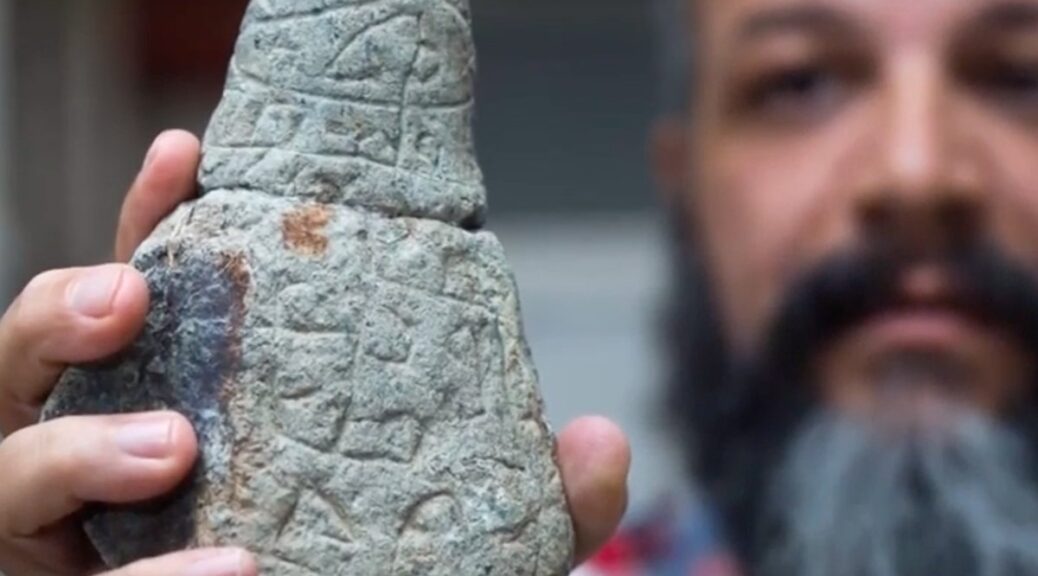800 Ancient Stones with Hebrew Writing in Puerto Rico Authenticated!
The mysterious origins of a collection of mysterious statuettes from Puerto Rico, long ago believed to have been made by Jews from the “10 Lost Tribes” exiled from the land of Israel in ancient times, are now closer to being understood thanks to Israeli technology.
The objects were flown to Israel for analysis at the Use-Wear Analysis Laboratory of the University of Haifa’s Zinman Institute of Archeology, which specializes in revealing how various objects were made, what tools were used to make them, and the era of the techniques and tools used. Lab Director Iris Groman-Yaroslavsky confirmed that the objects were carved in the 16th century, and she discovered evidence that some of the objects were coated in gold and red paint.
“This is definitely one of the strangest and most fascinating stories I’ve been involved in,” Groman-Yaroslavsky said. “To date, we have not found any similar carved stone art objects from this region of America, and many researchers assumed that they must be fake. However, the microscopic tests we performed show beyond any doubt that the stones were carved around 600 years ago.”
The story of these objects, known as the Library of Agüeybaná, sounds like the plot of an Indiana Jones movie.
In the 19th century, a Puerto Rican monk by the name of José María Nazario presented a collection of some 800 carved stone statuettes. Some had a human form, while others appeared to be artistic or ritual items. Many were engraved with a previously unknown form of writing.

No similar statuettes or art objects have ever been found from this region of America, and the markings bore no resemblance to the writing systems developed by the Aztecs or Mayans.
Nazario claimed that an old woman had invited him to her mountain hut and told him of a treasure her family had been guarding for centuries. He said that she gave him detailed instructions to find the treasure.
Nazario followed her instructions and headed deep into the mountains, eventually reaching a pit covered by a large stone, just as the woman had told him. When he removed the stone, he found hundreds of statuettes. He thought these were objects made by members of the 10 Lost Tribes of Israel.

Over the years, different researchers raised various suggestions about the stones and the engravings they bear. Some suggested that while some of the stones are authentic, others were forged by local people in the 19th century when they saw the great interest the statuettes had created. Other scholars claimed that all the statuettes were forged by Nazario himself.
In 2001, a research student named Reniel Rodríguez Ramos saw the stones during a study trip and returned to investigate further after completing his doctorate in pre-Columbian cultures.
“I decided to study the stones from scratch – to come to a ‘clean slate’ without any assumptions about whether they are real or fake, and to let the findings talk,” explained Rodríguez, now a professor at the University of Puerto Rico. After a long search, Rodríguez came to Groman-Yaroslavsky. She confirmed that the stones were carved in antiquity.
“Under the microscope, we can see the erosion of the stones and the brown-gray patina that is typically found when items have been buried or exposed to the ravages of nature for extensive periods,” she said.
“The items are made from a mineral that was originally a greenish-black, but the erosion covers the engravings across the entire item, and there is no evidence of any modern manipulation that would have exposed the natural surface of the mineral,” she explains.
The analysis also revealed remnants of gold coating on some of the items. This reinforces the hypothesis that the items were used in ancient worship.
Remnants were also found of a red paint covering parts of the eyes and mouths in the figures, reflecting a complex process of design and finishing. Gold and ochre mines can be found in Puerto Rico, and there is extensive evidence regarding the use of these minerals in ritual contexts.
The association with ritual activity became even more apparent when the facial design details were examined. “The items were clearly struck with a solid object since we can see deliberate destruction around the nose and chin,” said the Israeli researcher.
Rodríguez is now continuing his quest by bringing the collection to an expert in the ancient writing systems of pre-Columbian America.
